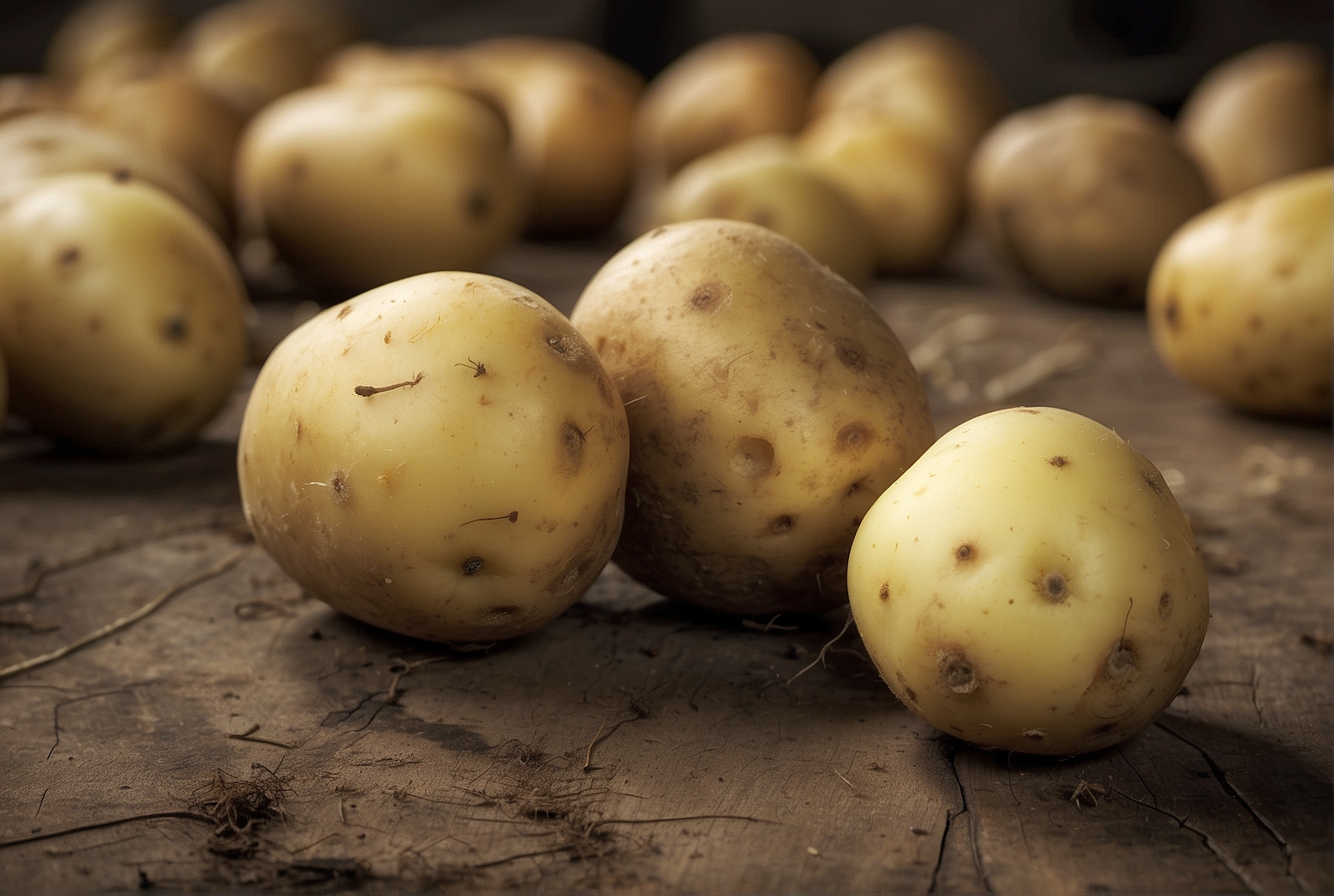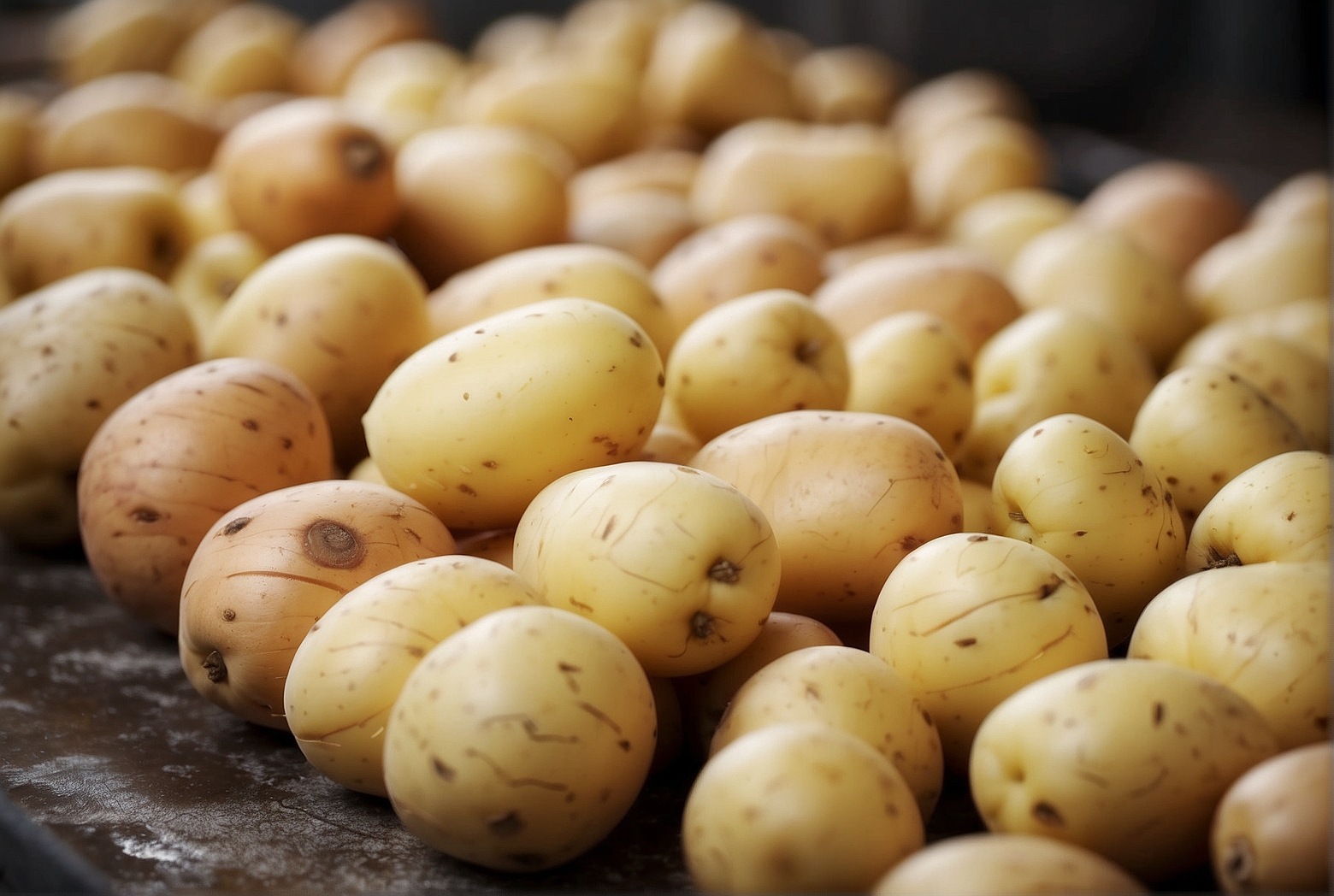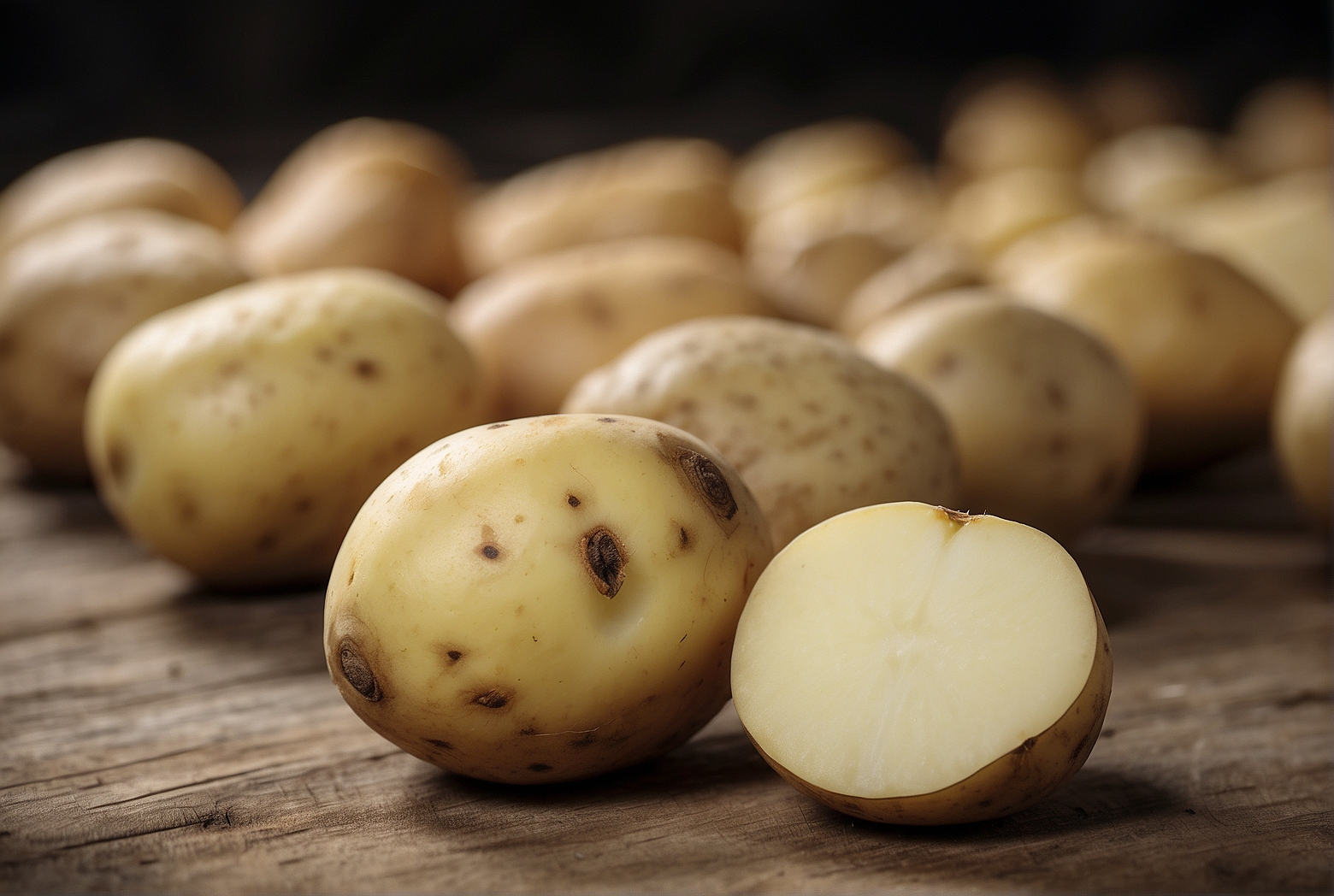Last Updated on April 8, 2024 by Tony Manhart
Are you a potato lover who can’t resist the perfect crispy french fries or a creamy mashed potato? If so, then you’ve probably heard of Kennebec potatoes. But did you know that there are two types of Kennebec potatoes? In this article, we’ll explore the fascinating difference between determinate and indeterminate Kennebec potatoes. Get ready to uncover the secrets behind these delicious tubers and discover which variety might be best for your culinary adventures.
Definition of Kennebec Potatoes
Kennebec potatoes are a popular variety of potatoes known for their versatility and excellent cooking qualities. They are medium to large in size with a slightly oblong shape and a pale yellow skin. The flesh of Kennebec potatoes is creamy white and has a firm and smooth texture. These potatoes are renowned for their ability to hold their shape well when cooked, making them suitable for a wide range of culinary applications.
Overview of Kennebec Potatoes
Originally bred in the early 1940s by the USDA and the Maine Agricultural Experiment Station, Kennebec potatoes quickly gained popularity among farmers and consumers alike. They were named after the Kennebec River, which flows through Maine and is known for its rich agricultural heritage. Today, Kennebec potatoes are widely cultivated and enjoyed for their delicious taste and reliable performance in the kitchen.
Origin of Kennebec Potatoes
As mentioned earlier, Kennebec potatoes were developed in the 1940s by the USDA and the Maine Agricultural Experiment Station. The breeders aimed to create a potato variety that had excellent processing qualities and could withstand pests and diseases prevalent in the region. Through careful crossbreeding, they were successful in developing the Kennebec potato, which quickly became a staple crop for farmers in Maine and beyond.

Characteristics of Kennebec Potatoes
Kennebec potatoes possess several distinct characteristics that set them apart from other potato varieties. Here are some of their notable features:
-
Versatility: Kennebec potatoes are incredibly versatile and can be used in various ways, including baking, boiling, mashing, frying, and roasting. Their ability to hold their shape makes them perfect for dishes like potato salad and gratins.
-
Texture: The flesh of Kennebec potatoes is firm and smooth, with a creamy texture when cooked. This makes them incredibly enjoyable to eat and adds a pleasant mouthfeel to any dish in which they are used.
-
Flavor: Kennebec potatoes have a mild and slightly sweet flavor that is well-balanced and loved by many. Their subtle taste allows them to complement a wide range of ingredients and seasonings, making them a favorite among chefs and home cooks alike.
-
Appearance: With its pale yellow skin and creamy white flesh, the Kennebec potato has an attractive appearance, making it visually appealing when served as part of a dish or as a standalone side.
Popular Uses of Kennebec Potatoes
Kennebec potatoes are highly versatile and can be used in various culinary applications. Some of the popular uses of these potatoes include:
-
French Fries: The firm texture and excellent frying qualities of Kennebec potatoes make them an ideal choice for making crispy and delicious French fries.
-
Mashed Potatoes: The creamy texture of Kennebec potatoes lends itself well to making silky smooth mashed potatoes. Their ability to hold their shape even when mashed ensures a fluffy and luscious end result.
-
Roasted Potatoes: The firm texture and slightly sweet flavor of Kennebec potatoes make them perfect for roasting. Whether it’s roasted with herbs and spices or tossed with olive oil for a simple side dish, the Kennebec potato provides a delightful roasted experience.
-
Potato Salad: Kennebec potatoes are a popular choice for making potato salad due to their ability to hold their shape after cooking. Whether it’s a classic mayonnaise-based salad or a tangy vinaigrette-based version, Kennebec potatoes add a delightful texture and flavor to any potato salad recipe.
Understanding Determinate and Indeterminate Potatoes
Before delving into the specific types of Kennebec potatoes, it is essential to understand the concepts of determinate and indeterminate potatoes.
Definition of Determinate Potatoes
Determinate potatoes, also known as bush potatoes, are characterized by their limited growth and compact habit. These potatoes have a predetermined size and stop growing once they reach their full maturity. Determinate potatoes tend to produce most of their tubers closer to the surface of the soil and have a concentrated harvest period.
Definition of Indeterminate Potatoes
Indeterminate potatoes, also referred to as vining potatoes, exhibit continuous growth throughout the growing season. Unlike determinate potatoes, they do not have a predetermined size and continue to produce tubers as long as the growing conditions are favorable. Indeterminate potatoes produce tubers at various depths within the soil and have a more extended and staggered harvest period.
Comparison of Determinate and Indeterminate Potatoes
Here is a side-by-side comparison of determinate and indeterminate potatoes:
- Growth Habit: Determinate potatoes have a bushy and compact growth habit, while indeterminate potatoes display vining growth with sprawling foliage.
- Tuber Production: Determinate potatoes tend to produce a higher concentration of tubers closer to the soil’s surface, whereas indeterminate potatoes produce tubers at varying depths.
- Harvest Period: Determinate potatoes have a concentrated harvest period, making them easier to harvest all at once. Indeterminate potatoes have a more extended and staggered harvest period, requiring multiple harvests.
- Growth Restrictions: Determinate potatoes stop growing once they reach their predetermined size, while indeterminate potatoes continue growing as long as the conditions are favorable.
Now, let’s explore the determinate and indeterminate variations of Kennebec potatoes.
Determinate Kennebec Potatoes
Determinate Kennebec potatoes refer to a specific type of Kennebec potatoes that exhibit the growth characteristics of determinate potatoes.
Description of Determinate Kennebec Potatoes
Determinate Kennebec potatoes share the same physical characteristics as regular Kennebec potatoes. They have medium to large-sized tubers with a slightly oblong shape, pale yellow skin, and creamy white flesh. The difference lies in their growth habit.
Growth Habit of Determinate Kennebec Potatoes
Determinate Kennebec potatoes have a bushy and compact growth habit. They typically grow to a predetermined size and stop their growth once they reach maturity. The foliage of determinate Kennebec potatoes tends to be more contained and less sprawling compared to indeterminate varieties.
Harvesting Determinate Kennebec Potatoes
One advantage of determinate Kennebec potatoes is that they have a concentrated harvest period. Since most of the tubers are produced closer to the surface, they can be harvested all at once during this period. This makes harvesting easier and more efficient, especially for gardeners with limited time or space.
Advantages and Disadvantages of Determinate Kennebec Potatoes
Some advantages of determinate Kennebec potatoes include:
-
Easy Harvest: The concentrated harvest period of determinate Kennebec potatoes allows for easier and more efficient harvesting.
-
Space Saving: Their compact growth habit makes them suitable for gardens with limited space or containers.
-
Earlier Harvest: Determinate Kennebec potatoes often have an earlier maturity period compared to their indeterminate counterparts, allowing for an early harvest.
However, there are a few disadvantages to consider:
-
Limited Yield: Determinate Kennebec potatoes tend to produce a smaller overall yield compared to indeterminate varieties due to their restricted growth.
-
Less Storability: These potatoes are not known for their long-term storage capabilities and are best used fresh or within a relatively short period.
-
Greater Vulnerability: Determinate Kennebec potatoes may be more susceptible to pests and diseases since their growth is less vigorous and spread out.
Indeterminate Kennebec Potatoes
Indeterminate Kennebec potatoes are another variation of Kennebec potatoes, displaying the growth characteristics of indeterminate potatoes.
Description of Indeterminate Kennebec Potatoes
Indeterminate Kennebec potatoes share the same physical attributes as regular Kennebec potatoes. They have medium to large-sized tubers with a slightly oblong shape, pale yellow skin, and creamy white flesh. The key difference is their growth habit.
Growth Habit of Indeterminate Kennebec Potatoes
Indeterminate Kennebec potatoes have sprawling vines and foliage that continue to grow throughout the season. Unlike determinate potatoes, they do not have a predetermined size and can produce tubers as long as the growing conditions are favorable.
Harvesting Indeterminate Kennebec Potatoes
One characteristic of indeterminate Kennebec potatoes is their more extended and staggered harvest period. Since the tubers are produced at various depths within the soil, they may be harvested over multiple occasions. This can provide a continuous supply of fresh potatoes throughout the season.
Advantages and Disadvantages of Indeterminate Kennebec Potatoes
Indeterminate Kennebec potatoes offer several advantages:
-
Higher Yield Potential: Indeterminate Kennebec potatoes have a greater yield potential compared to their determinate counterparts due to their continuous growth and tuber production.
-
Extended Harvest Period: The more extended and staggered harvest period allows for a continuous supply of fresh potatoes throughout the season.
-
Improved Disease Resistance: The vigorous growth habit of indeterminate Kennebec potatoes can contribute to better disease resistance, as the plants are better equipped to fight off pests and pathogens.
However, there are a few disadvantages to consider as well:
-
Space Requirements: Indeterminate Kennebec potatoes require more space due to their sprawling growth habit. They may not be suitable for smaller gardens or containers unless proper support and space management techniques are employed.
-
Harvesting Challenges: The multiple harvests required for indeterminate Kennebec potatoes can be more time-consuming and labor-intensive compared to the concentrated harvest of determinate varieties.
-
Later Maturity: Indeterminate Kennebec potatoes typically have a longer maturity period, which may delay the time before you can enjoy your first harvest.
Differences Between Determinate and Indeterminate Kennebec Potatoes
Now that we have explored determinate and indeterminate Kennebec potatoes individually, let’s compare them side by side in terms of various key factors:
Plant Height and Size
Determinate Kennebec potatoes have a more compact and bushy growth habit, typically reaching a predetermined size. Indeterminate Kennebec potatoes, on the other hand, have sprawling vines that can grow as long as the growing conditions permit.
Tuber Yield
Indeterminate Kennebec potatoes generally have a higher yield potential compared to determinate varieties due to their continuous growth and tuber production.
Resistance to Diseases
The vigorous growth habit of indeterminate Kennebec potatoes can contribute to improved disease resistance compared to determinate varieties, as the plants are better equipped to fight off pests and pathogens.
Maturity Period
Determinate Kennebec potatoes often have an earlier maturity period, allowing for an earlier harvest. Indeterminate Kennebec potatoes typically have a longer maturity period, requiring more time before the first harvest.
Storage
Determinate Kennebec potatoes are not known for their long-term storage capabilities and are best used fresh or within a relatively short period. Indeterminate Kennebec potatoes, with their larger yields, may require more storage space and can be stored for longer periods given appropriate storage conditions.
Ideal Growing Conditions
Both determinate and indeterminate Kennebec potatoes thrive in well-drained, loose soil with ample organic matter. They prefer a pH range of 5.0 to 6.0 and require adequate sunlight and water.
Best Uses for Determinate Kennebec Potatoes
Determinant Kennebec potatoes can be used in a variety of culinary applications. Some of the best uses for these potatoes include:
Cooking Applications
The firm and waxy texture of determinate Kennebec potatoes make them ideal for dishes that require the potatoes to hold their shape. They are perfect for boiling, roasting, and using in potato salads.
Storage and Shelf Life
Determinate Kennebec potatoes are best used fresh as they have a limited storage life. They can be stored for a short period under proper storage conditions, but their quality may deteriorate over time.
Preferred Culinary Techniques
Boiling or steaming determinate Kennebec potatoes will result in tender yet firm potatoes suitable for salads or side dishes. Roasting these potatoes will create a crispy exterior while maintaining a soft interior.
Best Uses for Indeterminate Kennebec Potatoes
Indeterminate Kennebec potatoes offer a range of culinary possibilities. Here are some of the best uses for these potatoes:
Cooking Applications
Indeterminate Kennebec potatoes can be used in a wide variety of cooking applications, including boiling, baking, frying, and mashing. Their versatility allows them to work well in soups, stews, casseroles, and many other dishes.
Storage and Shelf Life
Due to their larger yields and potentially longer storage life, indeterminate Kennebec potatoes can be stored for an extended period under optimal storage conditions. This makes them suitable for use throughout the year, even after the growing season has ended.
Preferred Culinary Techniques
Indeterminate Kennebec potatoes are excellent for mashing due to their creamy texture. They can also be baked or fried to create crispy and flavorful dishes.
Factors to Consider When Choosing Between Determinate and Indeterminate Kennebec Potatoes
When deciding between determinate and indeterminate Kennebec potatoes, several factors should be taken into consideration:
Space Availability
If you have limited gardening space or wish to grow potatoes in containers, determinate Kennebec potatoes may be a better choice due to their more compact growth habit. Indeterminate varieties require more space and support.
Harvesting Preferences
Consider whether you prefer a concentrated harvest or an extended and staggered harvest. Determinate potatoes provide a single harvest, while indeterminate potatoes require multiple harvests throughout the season.
Gardening Goals
Think about your gardening goals and objectives. If you are looking for a higher yield or an extended supply of fresh potatoes, indeterminate Kennebec potatoes may be the better choice. If you prefer a smaller yield and easier harvest, determinate varieties may be more suitable.
Pest Resistance
Indeterminate potatoes generally have a better ability to resist pests and diseases due to their vigorous growth and increased vitality. If you are concerned about pest infestations, indeterminate Kennebec potatoes may be a safer choice.
Disease Resistance
Indeterminate Kennebec potatoes, with their vigorous growth habit, tend to have better disease resistance compared to determinate varieties. Consider the prevalent diseases in your area and choose accordingly.
Tips for Successful Cultivation of Kennebec Potatoes
To ensure a successful and rewarding experience in growing Kennebec potatoes, consider the following tips:
Soil Preparation
Prepare the soil well by removing stones, weeds, and debris. Add organic matter such as compost or well-rotted manure to improve soil fertility and drainage.
Planting Techniques
Plant Kennebec potatoes in well-drained soil and provide adequate spacing between plants. Depending on the growth habit, determinate plants may require less space compared to indeterminate varieties.
Fertilization
Feed your Kennebec potatoes with a balanced and slow-release fertilizer before planting. Additional fertilizer applications may be necessary during the growing season, especially for indeterminate varieties with their longer growth period.
Watering Requirements
Ensure consistent and adequate watering throughout the growing season, especially during dry periods. However, avoid overwatering, as this can lead to diseases and tuber rot.
Weed Control
Regularly remove weeds around your potato plants, as they can compete for nutrients and space. Hand-weeding or mulching can be effective methods to control weeds.
Pest and Disease Management
Monitor your potato plants for any signs of pests or diseases, and take appropriate action promptly. Practice crop rotation and employ organic pest control methods whenever possible.
Harvesting Methods
Harvest your Kennebec potatoes when the foliage has died back, and the skins are fully set. Gently dig the tubers out of the soil, taking care not to damage them. Keep them in a cool, dark, and well-ventilated place for short-term storage.
Conclusion
In summary, Kennebec potatoes are versatile and delicious varieties that can be an excellent addition to any kitchen garden. Understanding the differences between determinate and indeterminate Kennebec potatoes is crucial in selecting the right type for your needs. Determinate varieties offer concentrated yields and ease of harvest, while indeterminate varieties provide higher yields and an extended harvesting period. Consider factors such as space availability, harvesting preferences, gardening goals, pest resistance, disease resistance, and storage requirements when making your decision. With proper care and cultivation techniques, you can enjoy a bountiful harvest of delicious Kennebec potatoes that will elevate your culinary creations.
Tony Manhart is a passionate gardener who has been tending to gardens for over 20 years. He takes pride in creating beautiful outdoor spaces with plants, trees, and shrubs that can thrive in any environment. He loves to share his knowledge with others and has taught classes on gardening basics and advanced techniques. He is committed to sustainability, using natural and organic methods to create and maintain gardens. He also works with local organizations to create green spaces for communities. When he’s not gardening, Tony enjoys hiking, reading, and spending time with his family.



